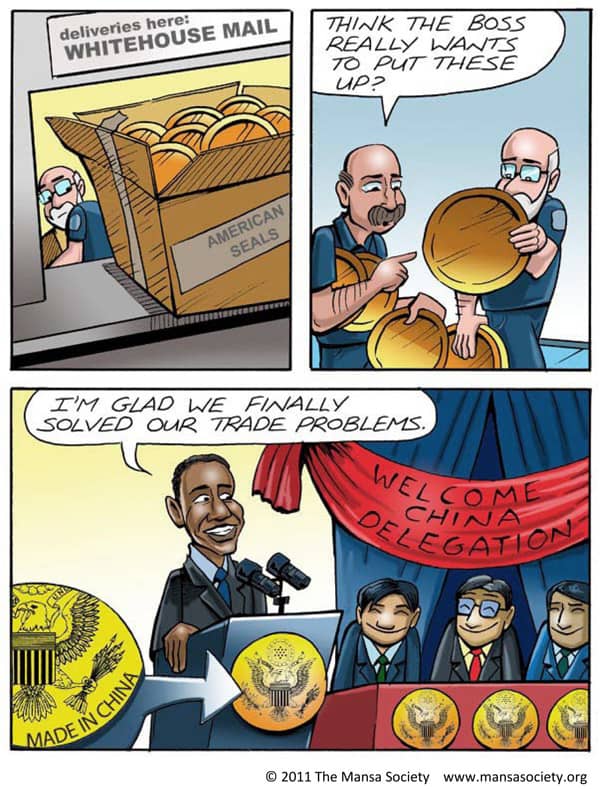
The digitalization of the world, coupled with low Chinese wages and the enormous Chinese-held American debt and our growing trade deficit with them, may actually be the first shots heard round the world in the re-colonization of America (or at least America’s businesses)
No one would argue that one of our most complex international trading relationships is ours with China. To feel the atmospherics of that relationship, I decided to get a reality check with a trip to China’s principal American retailer, Walmart.

Stephan Helgesen
I knew I’d find a ton of Chinese-made products there, but I wasn’t prepared for the sheer number of them. Looking only for well-known name brands, I charted a course to the housewares, sporting goods and hardware departments and made these observations about the manufacturing sites of well-known American brands: Oneida Silverware (Indonesia); Mr. Coffee coffeemakers and Hamilton Beach toasters (China); Master Lock padlocks (assembled in Mexico); GE room air conditioner, Stanley tools, Pennzoil multi-use pumps, Coleman tents, Daisy air rifles and Head tennis rackets (China).
Most clothing was made outside the United States, like Wrangler cargo pants (Nicaragua), but the prize of the day went to those famous Danish Lego toys that were made in Denmark, Hungary, Mexico and China (the same toy!).
I could have stayed for hours and ticked off product after product that bore a “Made Elsewhere” label, but it got too depressing. Almost the entire assortment of the electronic goods we buy for our homes are manufactured or assembled overseas, like computers and peripherals, stereo equipment, widescreen televisions and mobile phones – all from Southeast Asia and China. It’s astonishing how many Chinese-made products populate the lower-value end of the price spectrum. They range from plastic-extruded items to drop-forged tools. They’re actually the “cash cows” of China’s production, made at factories employing low- or no-skilled labor.
Many of these jobs were once the province of American workers, but no more. They’ve been exported to countries paying bargain-basement wages that offer borderline if not deplorable working conditions.
In the mid-80s, I helped American companies set up offshore garment production in the Caribbean Basin under the Caribbean Basin Initiative after the invasion of Grenada (the CBI was designed to help improve the economies of the region and prevent any further flirtations with Communism). U.S. executives were ecstatic when they learned they could make large profits by paying less for local labor. Several were also glad that OSHA wasn’t lurking around every corner, until I reminded them that the U.S. government support they were getting (quota and tariff relief) came at a price.
The price was treating the foreign workers as if they were in the United States, with the same kind of workplace protection that we enjoy here. It was a tough sell, because other countries in the Far East, Asia and South America were offering better incentives, lower wages and exemption from U.S. workplace regulations.
Is further American job loss on the horizon?
The answer to that question may very well be “yes,” and the next target may be the only viable sector we have left… services. Earlier this year, Steve Jobs stepped down as CEO of Apple and, just a few weeks ago, Jobs died. While I greatly admire what his company did to create products with universal appeal, I wonder if companies like Apple or competitors like Microsoft should get the Businessman’s Medal of Honor or the Medal of Outsourcing?
The truth is that while the computer has empowered our world, it has also flattened it, as author Thomas Friedman said in his book, “The World is Flat.”
Because of super-low wages and the computer-driven modernization of third-world country factories, formerly uncompetitive countries have won U.S. manufacturing contracts at unprecedented levels. If we’re not careful, the same thing could happen to our service sector.
While you won’t send your rug to a dry cleaner in Pakistan or get your hair cut in Thailand, you might be getting your taxes done in India via computer or get help setting up your new computer via an overseas call center.
The digitalization of the world, coupled with low Chinese wages and the enormous Chinese-held American debt and our growing trade deficit with them (see stats below) may actually be the first shots heard round the world in the re-colonization of America (or at least America’s businesses). The United States must reassess its global presence and learn to make better longer-term decisions that do not negatively impact our ability to compete or severely weaken an economy that was once the envy of the world. Underestimating China is a mistake we make at our own peril.
(The China stats: Goods deficit with China was $28.2 billion in Aug. 2010 and $28.9 billion in Aug. 2011. U.S. exports were $7.2 billion in Aug. 2010 and $8.4 billion in Aug. 2011, while imports from China were $35.4 billion in Aug. 2010 and $37.4 billion in Aug. 2011. Compare these figures to Aug. 2001, when U.S. exports were $1.9 billion, U.S. imports were $10 billion and the monthly deficit with China was $8.1 billion.)
Stephan Helgesen is a retired foreign-service officer who lived and worked in 24 countries. He was a small-business owner on three separate occasions. He is now the honorary consul for Germany in New Mexico and owner of Second Opinion Marketing, an Albuquerque export consultancy. He can be reached at helgesen@2ndopinionmarketing.com.